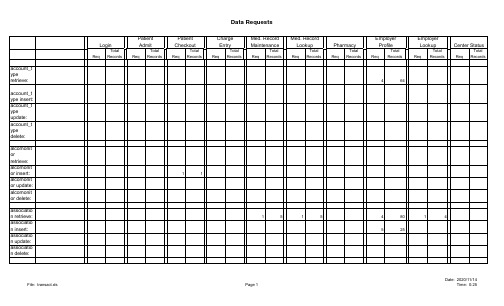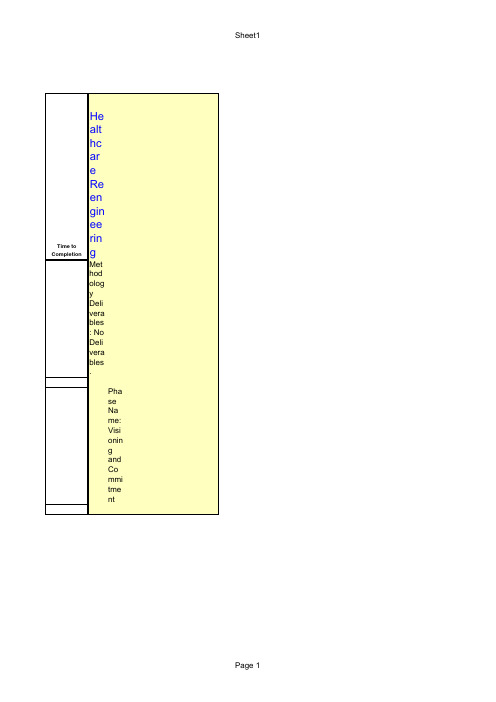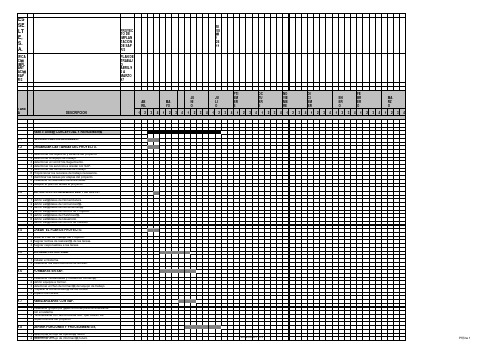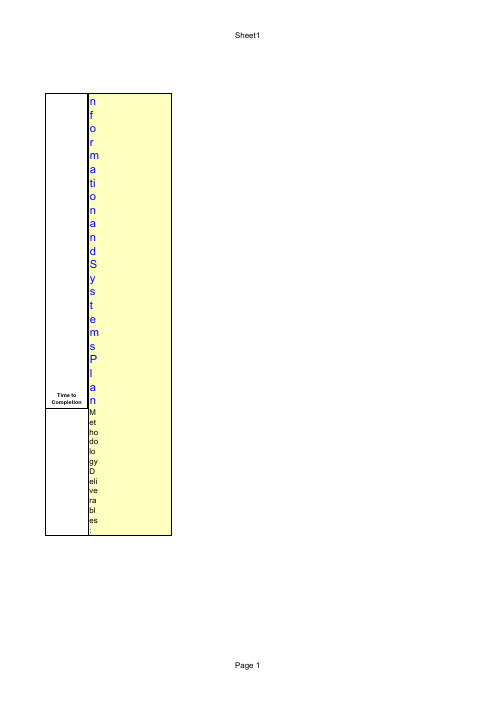安达信咨询方法与工具资料库IOWORK
- 格式:xls
- 大小:70.00 KB
- 文档页数:188






Init. ID#ORG01 - Customer Development Initiative:Define Critical Process Flows1.0Identify all critical processes and related activities20 (5 to 7per area)Relating to new organizational structure1.1Generate list of critical processes and activitiesthat support new organization structure1.2Map critical processes1.3Identify value added activities1.4Rank/prioritize critical process activities1.5Gain understanding of how processes areinterrelated1.6Achieve consensus from stakeholders/key processowners2.0Benchmark recommended process designs withAA experts 8Identify similar businessprocess designs within andoutside of industry2.1Confirm with AA marketing experts3.0Identify barriers/enablers to achieve new processdesign 5Determining barriers regardingthe flow of critical processesthat will hinder performance3.1Conduct brainstorming session to identify barriers3.2Identify potential impacts on processes3.3Conduct brainstorming session to identify enablers3.4Utilize Expert/Best Practices information3.5Confirm action plans and primary responsibilities4.0Finalize recommended processes withstakeholders/key process owners104.1Ensure understanding of critical process flows4.2Achieve consensus from stakeholders/key processownersInit. ID#ORG01 - Customer Development Initiative:Define Critical Process Flows5.0Communicate redesigned processes toorganization 10Communicating the transitionto the future organizationalstate5.1Develop information materials for organization5.2Customize communication plan5.3Communicate process design to organization6.0Integrate revised processes5Merge initiative with initiativesin other focus areas6.1Coordinate with other implementation teams6.2Identify implementation dates for redesignedbusiness processesInit. ID#ORG02 - Customer Development Initiative:Define Roles/Responsibilities1.0Review organizational needs based on projectfindings 2Assess the current availabilityand positioning of resources1.1Identify resource gaps 1.2Prioritize resource needs2.0Identify jobs and associated roles/responsibilitiesneeded for new organization design 15Managerial, professional,clerical (Key Acct. Mgrs, E/WMgrs for W&R, VP CD, DirCS, Inside Sales people, W&RMktg Mgrs)2.1Identify key positions2.2Detail all positions and determine staffing totals byposition/job type2.3Define reporting relationships (particularly cross-functional)2.4Assess the ability to relocate non-value addedactivities to support functions2.5Communicate the necessity to reduce non-valueadded activities3.0Develop draft job descriptions103.1Identify skill requirements for all key positions3.2Assign "weighting" ranks3.3Provide clearly defined and understoodresponsibilities and accountabilities4.0Identify all stakeholders/key process owners3HR involvement4.1Review list of key positions4.2Confirm job assignments as determined by skillsassessment initiative5.0Identify and allocate resources (FTEs & $s) to thecritical processes 5May follow skills assessmentphase5.1Confirm primary (high-impact or high resource)business processesInit. ID#ORG02 - Customer DevelopmentInitiative:Define Roles/Responsibilities5.2Allocate FTEs and associated $s based onidentified roles/responsibilities and findings fromthe skills assessment26.0Gain consensus from stakeholders/key processowners6.1Ensure understanding of organization structure6.2Finalize roles/responsibilities needed for newprocess design7.0Communicate roles/responsibilities to organization5Communicating the transitionto the future organizationalstate7.1Develop communication plan7.2Communicate roles/responsibilities to organizationInit. ID#ORG03 - Customer DevelopmentInitiative:Perform Skills Assessment1.0Conduct employee focus groups and interviews51.1Confirm necessary and desired skill sets1.2Confirm skill weightings1.3Review and utilize initial project interviewinformation1.4Conduct management and non-managementinterviews for additional information2.0Create skills assessment survey52.1Use focus groups and interview results to designsurvey2.2Review designed survey with stakeholders3.0Perform skills assessment203.1Conduct one, or a combination of, the followingskills assessment techniques:To be filled out by supervisors, and Departmental employeesA) Skills assessment survey (See workstep 3.0)Those surveyed may be askedto rate the organization andthemselves against theirperception of competitorcapabilities - Supervisory evaluation- Peer evaluations- Interdepartment evaluations- Self-assessmentsB) Individual skills assessment based on historicalperformance reviews, and downward and upwardevaluation trends3.2Identify gaps in skill sets3.3Identify positions that provide a strong fit withindividual's skill sets3.4Identify candidates that need training to fit certainpositions (trainable)3.5Identify candidates that should be assigned toother areas (non-trainable)Init. ID#ORG03 - Customer DevelopmentInitiative:Perform Skills Assessment3.6Assess need to procure outside resources/skills3.7Assign individuals to key positions4.0Communicate findings34.1Analyze survey and assessment findings4.2Finalize recommendations of personnel that arebest suited for each position4.3Review with stakeholders/key process owners4.4Finalize development opportunities for personnel5.0Plan curriculum35.1Identify improvement options to addressdevelopment needs5.2Stakeholders ensure that development candidatesare trained in the need areas6.0Develop coaching program5Build into organization duringimplementation phase6.1Create personal development instrument todetermine employee's strengths and developmentopportunities6.2Launch a coaching programInit. ID#ORG04 - Customer Development Initiative:Develop Performance Measures1.0Review corporate mission, vision, strategies, andKPIs 2Information from Strategyarticulation and KPI session1.1Confirm that overall corporate strategy issupported by new process design2.0Set performance targets for CustomerDevelopment, Marketing, and Customer Service 20Focus groups from keystakeholders2.1Align customer needs and develop objectives2.2Align targets to critical process flows2.3Develop performance measures that aremeasurable, actionable, linked to objectives,controllable, simple, credible, and integrated2.4Review effective performance measures fromother organizations2.5Prioritize the performance measures2.6Ensure that performance measures are balancedwith respect to cost, quality, and time2.7Review first draft of measures with stakeholders3.0Identify performance barriers53.1Identify skills, attitudes, and behaviors3.2Confirm clarity of roles3.3Determine communication effectiveness4.0Overcome performance barriers54.1Assign responsibility for overcoming barriers4.2Develop action plans to overcome barriers4.3Implement continuous learning plan4.4Leadership development4.5Develop communication model5.0Finalize performance measures with stakeholders55.1Gain consensus, and refine if necessaryInit. ID#ORG04 - Customer DevelopmentInitiative:Develop Performance Measures6.0Determine tools to monitor and evaluate10performance6.1Track results vs. targets6.2Manage future performance6.3Take corrective action7.0Reward and coach107.1Review existing performance appraisals7.2Integrate new performance measures intoappraisal process7.3Reward and incent desired behaviors7.4Review the coaching process for effectiveness7.5Develop recruiting and selection process criteria8.0Conduct cross-functional working sessions to5refine performance measures and developconsensus9.0Compensation review20Primary involvement from HR9.1Review existing compensation practices Key Account Mgrs, E/W MgrsW&R, Inside Sales people,DSMs, VP CD9.2Review Best Practices/alternatives9.3Design new compensation plans9.4Review with stakeholders9.5Determine transition plan9.6Roll-out。
The New York Times CompanyDocumentation of Benefits Process ControlsIntroduction:This document is divided into three categories of process controls: (I) Reliability of Information, (II) Operational Effectiveness and Efficiency and (III) Compliance With Laws and Regulations. Each section contains several control objectives, the risks each objective is designed to minimize and the controls that will be implemented to achieve the objectives. Each control description ends with the implementation vehicle it affects (i.e., system, process, policy, or change management). An overview of the category objectives appear below.Section I Overview: Reliability of Information:1.Employee Record Changes Are Properly Authorized And Accurately Recorded.2.Recorded Benefits Information Is Substantiated.Section II Overview: Operational Effectiveness And Efficiency:1.Critical Benefits Records Are Safeguarded.2.Benefits Administration Occurs In A Cost-Effective Manner.3. A Quality Benefits Administration Process/Service Is Provided To Employees.4.Performance Measurements Used To Control And Improve The Process AreReliable.Section III Overview: Compliance With Laws And Regulations:1.The Company Complies With Laws And Regulations.SECTION I: RELIABILITY OF INFORMATIONObjective 1: Employee Record Changes Are Properly Authorized And Accurately Recorded. All changes to employee records with respect to benefits administration and deductions are approved and accurately recorded on a timely basis.Risks:∙Potential for destruction or loss of benefits records.∙Unauthorized review or disclosure of confidential information.∙Processing of unauthorized changes to benefits.∙Errors resulting in inaccurate or loss of benefits will lead to disgruntled employees. Business Process Controls:e computer system controls (i.e., security password and ID) to precludeunauthorized access to computerized employee information records. Require employee entry via e-form or VRU of all changes to benefits status. Require edits, where possible, to occur at the source (e.g., employee address). (SYSTEM)B.Document requested changes on input forms (i.e., create audit trail). Precludeprocessing of changes to employee information without properly authorized input forms by building security into e-form and requiring appropriate signature on faxed/imaged documents. (SYSTEM)C.Maintain appropriate hard copies of documentation (according to state and federallegal requirements) regarding employee information (i.e., beneficiary firms and payroll deductions). (PROCESS & POLICY)D.Design front-end system to ensure the accuracy of employee-entered information(i.e., menu driven, drop down reference tables, etc.). (SYSTEM)E.Train employee to build familiarity with the VRU/e-form and thereby minimizeerrors. Train managers to ensure accurate system inputs and edits. (CHANGE MANAGEMENT)F.Monitor and maintain the front-end system to ensure that security access is updated.For example, new employees are promptly given access to the system and employees that have left the organization lose access to the system. (SYSTEM) Objective 2: Recorded Benefits Information Is Substantiated. The validity, accuracy and completeness of benefits-related information is periodically substantiated.Risks:∙Unauthorized transactions will remain undetected.∙Unauthorized or unreasonable benefits disbursements will result in excessive costs. Business Process Controls:A.Periodically confirm benefits information with employees. The annual statementsprocess (see process map) is designed to allow employees to confirm system inputs.(SYSTEM & PROCESS)B.Reconcile beneficiary form information with PeopleSoft HRMS data entered byemployee. (PROCESS)C.Reconcile payments to carriers with PeopleSoft HRMS data. Investigate and resolvedifferences. (PROCESS)D.Reconcile 401K loan payments to Vanguard with PeopleSoft data. (PROCESS)E.Quarterly reconcile G/L and stock activity. (PROCESS)F.Send employee a confirmation letter after any benefit change. (SYSTEM)SECTION II: OPERATIONAL EFFECTIVENESS AND EFFICIENCYObjective 1: Critical Benefits Records Are Safeguarded. Access to critical records is restricted to authorized personnel.Risks:∙Records will be destroyed or lost. This will preclude preparation of reliable financial and operating reports.∙Unauthorized personnel will alter computer programs.∙Records will be misused or altered by unauthorized personnel to the detriment of the company or its employees.Business Process Controls:AA Implement adequate controls over critical records. Establish written policy regarding access to critical records.(SYSTEM & POLICY)BB Use safes, locked cabinets, a secure tape and disk library, and off-site back up storage for records, computer files and programs, and related documentation of transactions. (POLICY)CC Centralize benefits records (e.g., beneficiary forms) at the SSC. (POLICY)DD Limit access to computerized records to authorized personnel. Use access control software and/or application specific access controls, together with appropriate user password procedures and physical controls over access to workstations, LANs and on-line terminals. (SYSTEM)Objective 2: Benefits Administration Occurs In A Cost-Effective Manner. Benefits at the SSC is cost-effective and efficiently administered.Risks:∙The company will incur excessive processing costs.Business Process Controls:A.Eliminate redundant data entry by automating the benefits administration process tocapture information directly from the employee through remote access systems.Electronically process that information. (SYSTEM)B.Establish policies for vendors and SSC employees to process interface data quicklyand verify compliance with policies. (PROCESS & POLICY)Objective 3: A Quality Benefits Administration Process Is Provided To Customers. A quality benefits administration process is provided to the customers of the process(i.e., the employees). Quality is defined by the customer.Risks:∙Incorrect payments and/or failure to address queries on a timely basis will lead to employee dissatisfaction.Business Process Controls:A.The SSC is the designated contact point for employees to contact with their queries.Answer employee queries regarding benefits on a timely basis, preferably at the time of first contact from the employee. If the issue is not resolved initially, inform the employee of the specific action that will be taken and when they will be contacted with a reply. Use a call tracking system to track problem through to resolution.(PROCESS)e relevant performance measures to monitor the quality of benefits administrationat the SSC. Solicit employee input on ways to improve the process and periodically assess employee satisfaction with the benefits offered and the SSC (see performance measures document). (PROCESS)Objective 4: Performance Measurements Used To Control And Improve The Process Are Reliable. Performance measurements for the benefits process are reliable for purposes of identifying process risks and making decisions to improve process effectiveness and efficiency.Risks:∙Inaccurate measurements will result in erroneous perceptions about process performance. This may result in inappropriate decisions.Business Process Controls:A.Collect the data required to assess process performance. Have employeesresponsible for the process calculate the measurements and periodically review them to ensure that they represent process performance (SYSTEM & PROCESS)B.Gather employee complaints and suggestions, so that the benefits process can beimproved continuously. Ensure that management and employees understand the linkage of the measures to customer satisfaction, and that they "buy in" to the use of these measures as tools to improve process performance. Link the measures to performance evaluations. (CHANGE MANAGEMENT)SECTION III: COMPLIANCE WITH LAWS AND REGULATIONSObjective 1: The Company Complies With Laws And Regulations. The benefits administration procedures used to process the company's benefits is in compliance with applicable laws and regulations (e.g., legal and union regulations on timing and method of payment).Risks:∙The company will incur fines or other penalties.∙Failure to comply with union regulations will lead to labor relations problems. Business Process Controls:A.Have the company's legal and personnel departments review all relevant laws andregulations and develop benefits administration procedures which comply with these regulations. Consult with industry and professional organizations, tradeunions or regulatory bodies about compliance with laws and regulations and possible future requirements. Monitor the political, law making and regulatory environment to ensure that the company continues to comply with industry standards and applicable laws and regulations. (POLICY)B.Utilize company's policies and procedures materials concerning compliance withlaws and regulations (i.e., COBRA, ESPP Contribution limit, stock options, 401(k), HCFA, etc.). Distribute these materials to those responsible for the formulation and administration of various business policies and procedures. (POLICY)C.Designate a legal officer who is generally responsible for compliance with laws andregulations and is available to advise management about the legal and regulatory ramifications of certain actions. (POLICY)D.Conduct discrimination testing to ensure that highly compensated employees are notinappropriately benefiting from participation in 401(k) plans than other employees.(PROCESS)E.Ensure that the company adheres to union regulations. Review all new contracts forimplications related to benefits and benefits reporting. (PROCESS)。